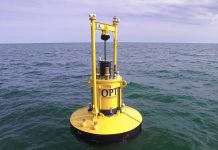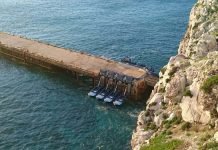Marsha Johnston
 “We’re still at the point where the car industry was of not knowing whether the engine should be at the front or the back,” quips Christopher Barry, chair of the Ocean Energy Technical and Research panel at the Society of Naval Architects and Marine Engineers. “At least a dozen companies are looking into [wave power]…with at least half a dozen main ideas for getting the energy out that are distinctly different and many variants on those themes. There are lots of opportunities and we don’t know which will be the winner.”
“We’re still at the point where the car industry was of not knowing whether the engine should be at the front or the back,” quips Christopher Barry, chair of the Ocean Energy Technical and Research panel at the Society of Naval Architects and Marine Engineers. “At least a dozen companies are looking into [wave power]…with at least half a dozen main ideas for getting the energy out that are distinctly different and many variants on those themes. There are lots of opportunities and we don’t know which will be the winner.”
In contrast, he notes, turbine technology being used for tidal power installations is well developed, with just some tweaking being done around the edges, such as creating floating versions. “Wave is quite a distance back from that,” he says. Indeed, tidal installations are beginning to deliver power to grids, such as Ocean Renewable Power Company’s (ORPC) Eastport, Maine deployment on September 13.
The lack of technological maturity hampers even the leaders in wave power, like Ocean Power Technologies, Inc. (Nasdaq: OPTT). Despite some notable project advances and a 38% decrease in product development costs in its fiscal 2013 first quarter ended July 31, 2012, OPT reported Friday a net loss of $4.4 million. The loss was smaller than last year’s first-quarter loss of $5 million.
But even in the face of continued losses, both Barry and Dr. Paul Jacobson, water power program manager at the Electric Power Research Institute, agree that OPT is the leader in wave power. “In terms of wave power in the US, [OPT] are out in front of everyone else,” says Jacobson.
Specifically, says Barry, OPT is the leader in “donut on a stick” technology that uses a “latching” technique to maximize the technology’s ability to generate electricity. “Latching is being widely studied, but [OPT] are probably the only folks commercializing latching technology,” Barry said, adding “whether the donut on the stick technology is the right thing to do is not yet certain.”
OPT’s chosen technology is not the most efficient, he says, extracting only slightly more than 50% of the wave’s total energy because it captures only the up-and-down motion, but he acknowledges that robustness in the ocean environment could ultimately trump higher efficiencies.
In the meantime, the U.S. Federal Energy Regulatory Commission awarded OPT the first license to build a grid-connected wave power station in the U.S. The 1.5-megawatt power station off Reedsport, Oregon will be based on OPT’s 150-kw PowerBuoy (PB150), which is in final assembly and inland testing. OPT expects the PB150 will be ready for deployment in early October, with actual deployment dependent on weather conditions. Following the Reedsport wave park, OPT says it intends to build up to 100 MW in Oregon. “It’s just a matter of scaling up. They will be gathering information as this first phase is deployed in order to support expansion,” says Jacobson.
OPT said its decline in product development costs was due primarily to the deployment of the PB150 off the coast of Scotland in 2011, and lower costs related to the Reedsport PB150 as it nears completion and deployment. The firm also says it is undertaking “other initiatives” to reduce the costs associated with wave power – in particular, the Reedsport buoy’s new direct-drive power take-off system that will have lower maintenance costs that the previous hydraulic PTO.
The quarter also brought an agreement with Lockheed Martin to develop a 19-megawatt wave energy project off Portland, Victoria, Australia and a Cooperative Research and Development Agreement with the U.S. Department of Homeland Security to demonstrate the use of its Autonomous PowerBuoy for ocean surveillance. In Australia, the two firms are focusing on permitting activity and getting the financing necessary to secure a previously announced A$66.5 million (US$69.5 million) grant from the Commonwealth.
Barry said it is still not clear which business model OPT intends to adopt. “Will OPT be a technology developer, build devices and lease them, or sell them to PG&E? We don’t know,” he said.
Marsha W. Johnston is a freelance writer based in the DC area, specializing in all areas of sustainable development, from renewable energy to agriculture and wildlife conservation.
This article was originally published on RenewableEnergyWorld.com and was republished with permission.




